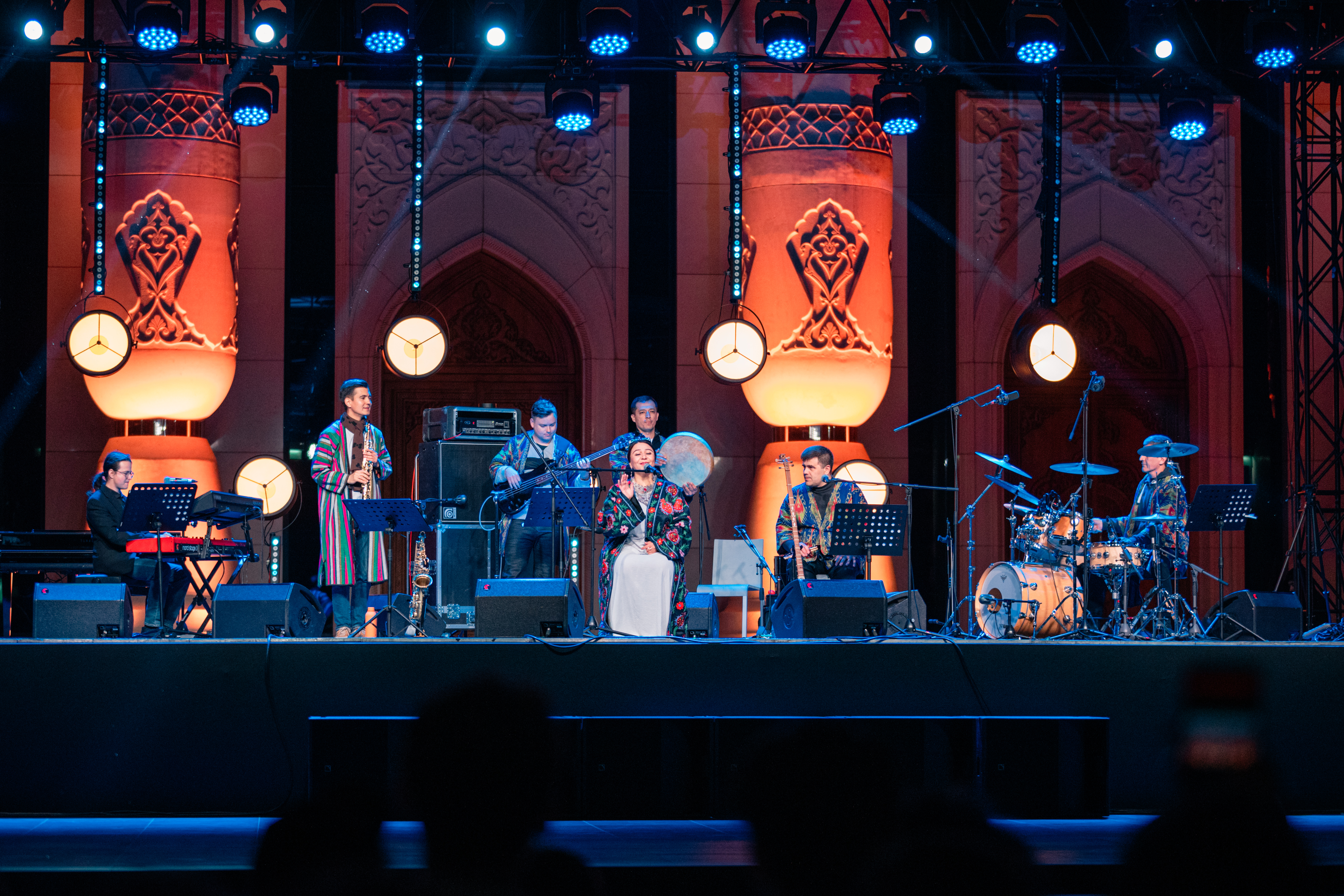
Culture • 03 April, 2025
Jazzirama: traditional jazz with Uzbek flavor
In Uzbekistan, traditions are cherished and upheld, which is reflected in all spheres of art and culture. Since its founding in 2007, the musical band Jazzirama has breathed new life into Uzbek jazz by blending ethnic motifs with a modern sound. This unique project, uniting talented musicians who are deeply passionate about their work, seamlessly blends the country's rich cultural heritage with an innovative approach to jazz, making their music distinctive. In an interview, saxophonist, composer, producer, educator, and band leader Saidmurat Muratov shared insights into the creative journey of the band, their views on the development of jazz in Uzbekistan, and how they merge contemporary trends with the rich musical heritage of their homeland.
– How did Jazzirama come into being?
– Jazzirama was born out of a long creative journey and serendipitous encounters. While studying at the State Conservatory of Uzbekistan, I met pianist and composer Sanjar Nafikov during concert rehearsals. Our joint performances and shared passion for jazz led us to a decision to work together. In 2007, we launched our first project, called Jam Five, consisting of five conservatory students. With this lineup, we gave our first solo concert at the Mark Weil Ilkhom Theater. Then we organized various interesting concerts and small projects. The name of our band changed over time, just as did the musicians who played with us.
At first, we performed American jazz, but by our second concert, we realized that merely imitating Western music wasn't entirely our path, we began searching for our own style. We grew up in Uzbekistan, a country with incredibly rich traditions. Why should we engage in imitation? Of course, we should learn from the masters, and there is much to take from foreign musicians in terms of professionalism, punctuality, time management, soundcheck nuances… Musically, there is also much to learn, but one day, while listening to Azerbaijani pianist Vagif Mustafazadeh, who masterfully combined jazz with mugham, I thought: why don’t we try doing the same with Uzbek music? That's how we started experimenting. At our second concert, when we were still called "Quartet S.M.", we performed the aria "Otmagay tong" from the Uzbek opera "Takhir and Zukhra". To perform this piece, I specifically prepared with the renowned Uzbek musician Batyr Dusumbetov, who taught me to play the nay (a traditional Uzbek flute). The response was overwhelming, and we realized we had chosen the right direction.
Jazzirama&Yogev Shetrit – Otmagay tong
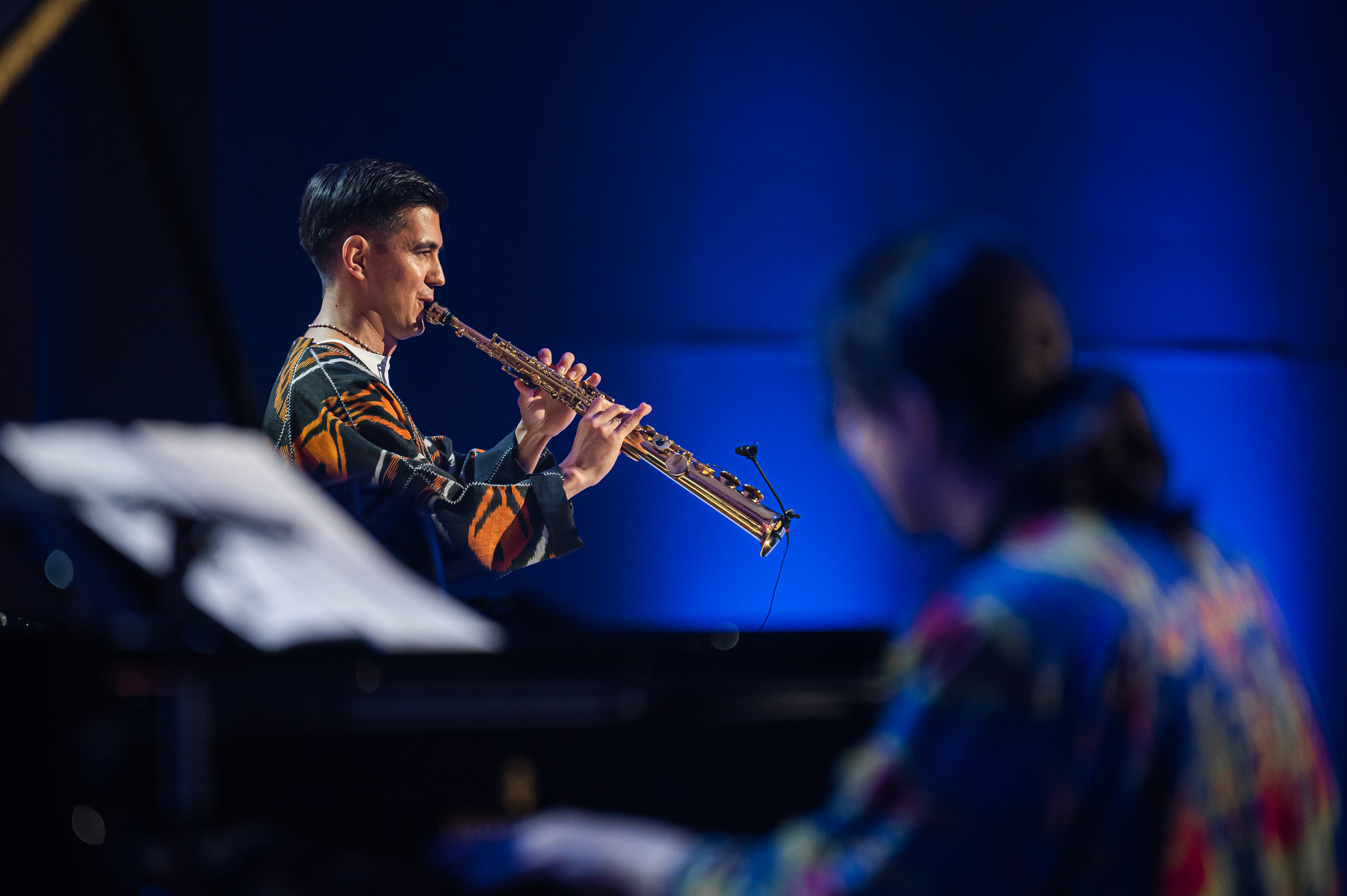
After that, we began composing our own pieces based on Uzbek music, and by 2013, under the name Jazzirama, we started actively developing this style. The name came from a project headed by Mansur Ganiyevich Tashmatov, in which I had previously participated. He believed that Jazzirama perfectly captured the spirit of jazz, and Sanjar and I decided to continue our creative journey under this name with his approval.
– What kind of music did the band members play before joining the group?
– Before coming together as a single band, each of us already had a certain level of experience in music. I have always loved playing pop music, jazz, and, of course, classical pieces, which greatly contribute to musical development. Sanjar, on the other hand, has been a rock musician his whole life, but over time, his creative path led him to jazz, and it was during this period that we met.
Besides us, our band includes another unique musician—Shavkat Matyakubov, a maqomist (maqom performer) and multi-instrumentalist who serves as an associate professor at the Uzbek National Institute of Musical Arts named after Yunus Rajabi. Shavkat plays the tanbur, sato, doira, surnay, and koshnay. He is a true one-man band, and his uniqueness lies in the fact that he is not only a maqom singer but also one of the few musicians who promotes Uzbek performing arts worldwide. Shavkat has traveled to more than 40 countries, performing maqoms, and even participated in a project with the world-renowned Dutch band/ensemble Atlas Orchestra, where he was invited without an audition to share the stage with them. He is more than just a performer – he shares his deep knowledge of maqom with us, acting as both a mentor and a guide into the world of Uzbek musical traditions.
As for the decision to play jazz with an Uzbek flavor, it felt natural for each of us. We have always understood that jazz is not just a genre/style but an entire culture that embodies freedom and democracy. Jazz was originated in an era of slavery and racial discrimination, and this spirit of freedom remains an integral part of it. Today, this musical style unites nations/people and helps build cultural bridges. For many years, Tashkent has hosted a jazz festival that attracts world-class stars and collects full concert halls, proving the growing interest in jazz in Uzbekistan. – How long did it take to find the right musicians to achieve the desired sound? – The "desired sound" is an ongoing process, and in essence, we are always in search of it. Even now, we are looking for interesting combinations of instruments and new ideas and forms. We can't say that we have already found the perfect style, that it is finalized and complete. There is always room for improvement, and that is what inspires us to keep experimenting. For example, Azerbaijani musicians, who started experimenting back in the 1960s, continue to search for new paths to this day, combining instruments and styles from different eras. We focus on their experience for inspiration and strive to create something unique. However, in Uzbekistan, the jazz culture is not well developed, which poses a certain challenge for us. We don’t have a jazz faculty in our music schools, and interest from listeners has only recently begun to grow. More people are now attending jazz festivals and concerts in Tashkent, but there is still a shortage of musicians with the necessary skills and experience. For example, Mansur Ganiyevich Tashmatov organizes concerts with an orchestra, gradually fostering interest in ethno-jazz, but the culture is still in its early stages of development. During a cultural exchange program at the University of Michigan, I shared sheet music and recordings from our first album with local musicians. They instantly understood our music and were ready to play with us. That deeply impressed me: they effortlessly interpreted our compositions even without knowing the intricacies of Uzbek traditional music. Later, while performing in Paris with pianist and professor of the Paris Conservatory Pierre de Bethmann, I once again felt how quickly musicians from different cultural backgrounds grasp and adapt to ethno-jazz. We played "Lazgi" and "Otmagay tong", and I realized that even if musicians are unfamiliar with Uzbek culture, they can still easily convey the spirit of our music. Unfortunately, due to the lack of a jazz culture in Uzbekistan, it is difficult for local musicians to quickly master such pieces. Mostly, they play pop and rock music. In 2024, we began collaborating with Olimjon Hakimov – a professional in the art of playing percussion instruments, known for his achievements in Uzbek and Latin American percussion. We performed together at several jazz festivals in Europe, and his joining the group was a significant event for us. Olimjon is a truly creative artist with his own projects, so he isn’t always available to play with us, but whenever he has time, he joins us because he is genuinely interested in ethno-jazz. His presence has added power and dynamism to our sound, and his energy and talent constantly inspire us to explore new musical frontiers. – What makes Uzbek ethno-jazz so appealing? – First and foremost, Uzbek ethnic music is our native sound. Since childhood, we’ve listened to the sounds of the nay, dutar, and maqom performances on the radio. Unfortunately, many don’t understand its depth, but in reality, it is sublime and spiritual, as maqom is built on the poetry of great poets. We collaborate with the Honored Artist of Uzbekistan, maqom performer Nodira Pirmatova, and I have repeatedly witnessed her playing the dutar. Tears would well up in the eyes – it’s music that touches the soul. Jazzirama is not the kind of project where boundaries define our actions. We chose this path because we truly love it all. It can be seen as a way of expressing gratitude to our homeland, where great figures like Al-Khwarizmi, Avicenna, and Al-Bukhari once lived and created. This is a global cultural center, and we must not forget its greatness. Uzbekistan is a place where life and creativity have always flourished, yet unfortunately, many people today underestimate its rich cultural treasures. For example, what some might call "a stick and two strings" is, in fact, a unique feature. The tanbur in the hands of masters like Turgun Alimatov becomes an instrument capable of conveying deep emotions and music that has lived for centuries. It is truly wonderful when people start showing interest in this music and recognizing its value. But most importantly, we do this because it is part of us, it runs through our veins. The choice of a piece to play is always connected to what we listen to and what inspires us. Sometimes, it’s old pop or folk recordings. Other times, I discover something interesting on vinyl records. For example, once I came across "Lazgi" performed by Nasiba Abdullayeva. I really liked how she interpreted the composition, giving it a pop sound while keeping its national style. It was a true fusion of the 1980s. Imagine this: the music starts, the vocals come in, and at some point, an electric guitar joins in, and its sound resembles the Khorezm accordion. That left a strong impression on us, and we decided to use that idea as the basis for our own version of "Lazgi". Some compositions we heard for the first time in pop performance. For example, the song "Sumbula" performed by Rayhon Ganieva. I immediately thought that this piece was worth working on. Sometimes one of us composes music at home on a computer, and then during rehearsals, we decide how to develop the composition and what to do with it next. It’s always a process of discovery, and with each new experiment, we uncover something unique for our band. – Which famous musicians have you performed with on the same stage? – One of our first collaborations happened at the Spring Jazz Festival in 2014. At that time, UNESCO was actively involving embassies of various countries to provide funding to bring artists at their expense. Thanks to this, we got the opportunity to play with American musicians, and among our first colleagues was the Ari Roland Jazz Quartet.
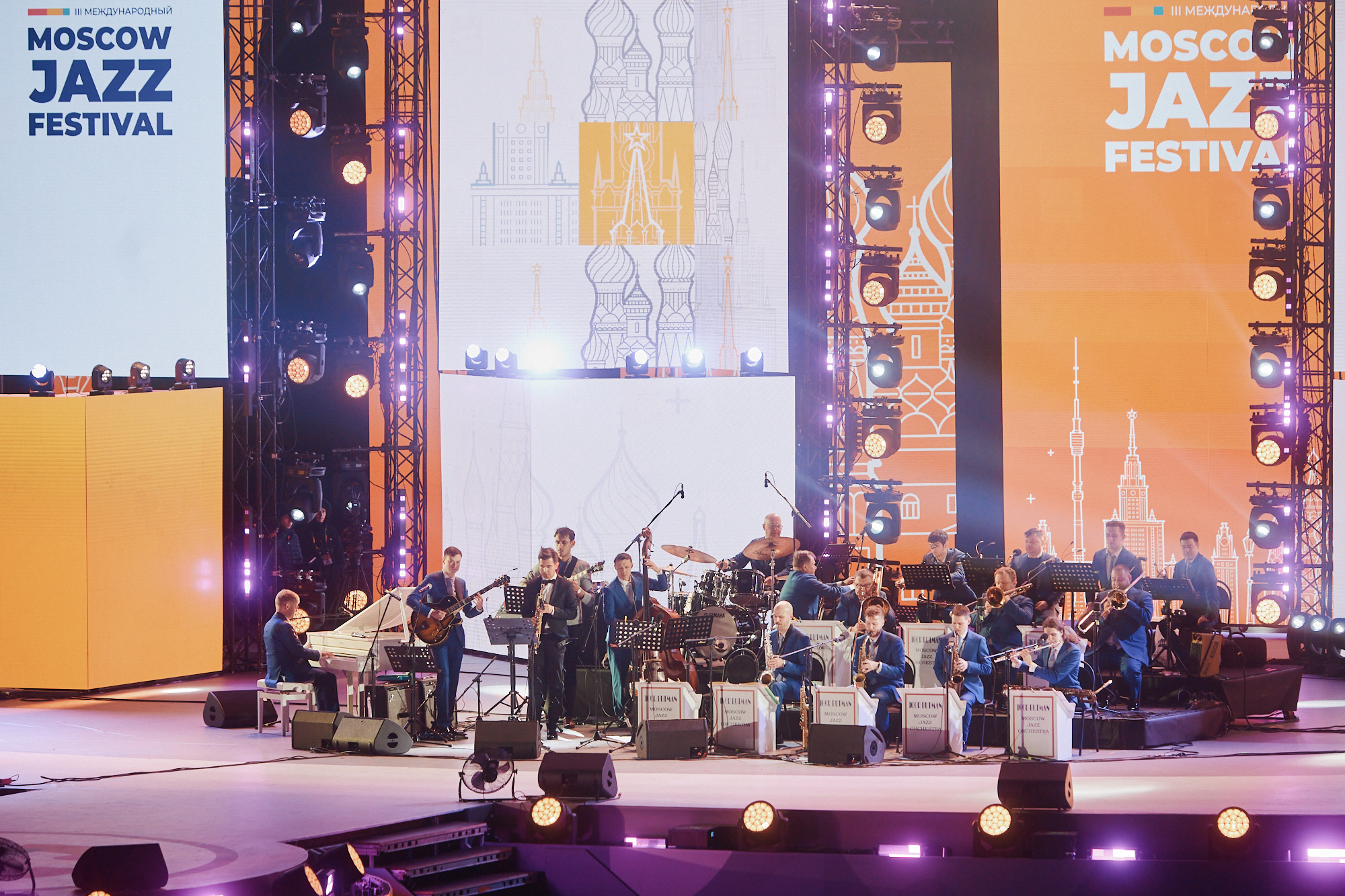
However, if we talk about more significant collaborations in Uzbek jazz, the most notable example would probably be our work with Pierre de Bethmann, a pianist and professor at the Paris Conservatory. In 2016, we had the honor of performing with him at a solo concert. Another notable collaboration was with Hervé Sellin, a professor at the Jazz and Improvised Music department at the Paris National Conservatory of Music and Dance, with whom we performed at his concert in Tashkent. This was a truly important moment for us, as Hervé Sellin is one of the leading figures in French jazz.
We have also performed several times with Canadian pianist David Braid at concerts at the Ilkhom Theater, at the Tashkent Jazz Festival, and in 2022, we had an amazing experience performing on the same stage with the "Turkiston" Chamber Orchestra.
Speaking of our plans for the future, we would very much like to collaborate with the State Symphony Orchestra of Uzbekistan under the direction of Kamoliddin Urinbaev and with the National Symphony Orchestra of Uzbekistan chaired by Alibek Kabdurakhmanov. We believe that working with these outstanding orchestras could lead to something truly fascinating and unique. We would also like to work with tanbur player Toir Askar, maqom performers Mohichehra Shomurotova and Munojat Yulchieva. One of our guiding stars is Sevara Nazarkhan, who has made her way onto the global stage, performing Uzbek pieces around the globe. And of course, we would love to create something unique with many other talented musicians as well.
Jazzirama&Yogev Shetrit – O'zbekiston
– In which international competitions and festivals has Jazzirama participated?
– We have participated in several international competitions and festivals. One of the first was the Bishkek Jazz Festival in 2009, where we won the Grand Prix for performing the ethno-jazz composition "Sary-Oy". In 2024, we received the "Future of Jazz" award at the St. Petersburg International Jazz Festival, which became a significant milestone for our group.
There aren’t many jazz competitions, and most of them are aimed at solo performers. For example, the Montreux Jazz Piano Competition for pianists and the Michael Brecker Competition for saxophonists. Sometimes, festival organizers add a competitive element by awarding prizes to inspire participants.
– What musical projects have you worked on? – One of the first projects I was involved in was the Ilkhom Jazz Club. This was my personal project, which still exists today, although it is currently on hold. The club was actively running from 2014 to 2018, hosting more than 30 concerts with local performers and nearly 50 masterclasses featuring guest musicians from abroad. Our idea was to create a kind of creative sandbox, and to some extent, we succeeded—the club gained recognition, and musicians from different countries started reaching out to us with performance proposals. However, we had to honestly explain that we didn’t have the funding to invite them. We received support from embassies and organizations like UNESCO, but we didn’t have our own funds. The next project was "Jazz Umidlari" (Jazz Hopes), which ran from 2019 to 2021 in collaboration with the creative workshop "Ariya" under the direction of Valentina Martirosyan. It served as a creative platform for children and teenagers passionate about jazz. For example, one of the participants was Madinabonu Odilova, who became a semifinalist on the show "Ovoz: The Voice of Uzbekistan", and with whom we continue to work. I have also taken part in educational projects supported by the U.S. Embassy. After traveling to the United States through a government program, I became an alumni, which opened up new opportunities. The embassy invites alumni to various events and offers the chance to apply for grants, which allowed us to win grants twice for the projects "Self-Expression Through Jazz Improvisation" and "Jazz as a Driver of Democratic Reforms". In addition, we conduct masterclasses at major music institutions in Tashkent, including: The Uspensky Music School, The Glière Music School, The College of Variety and Circus Arts, The State Conservatory of Uzbekistan
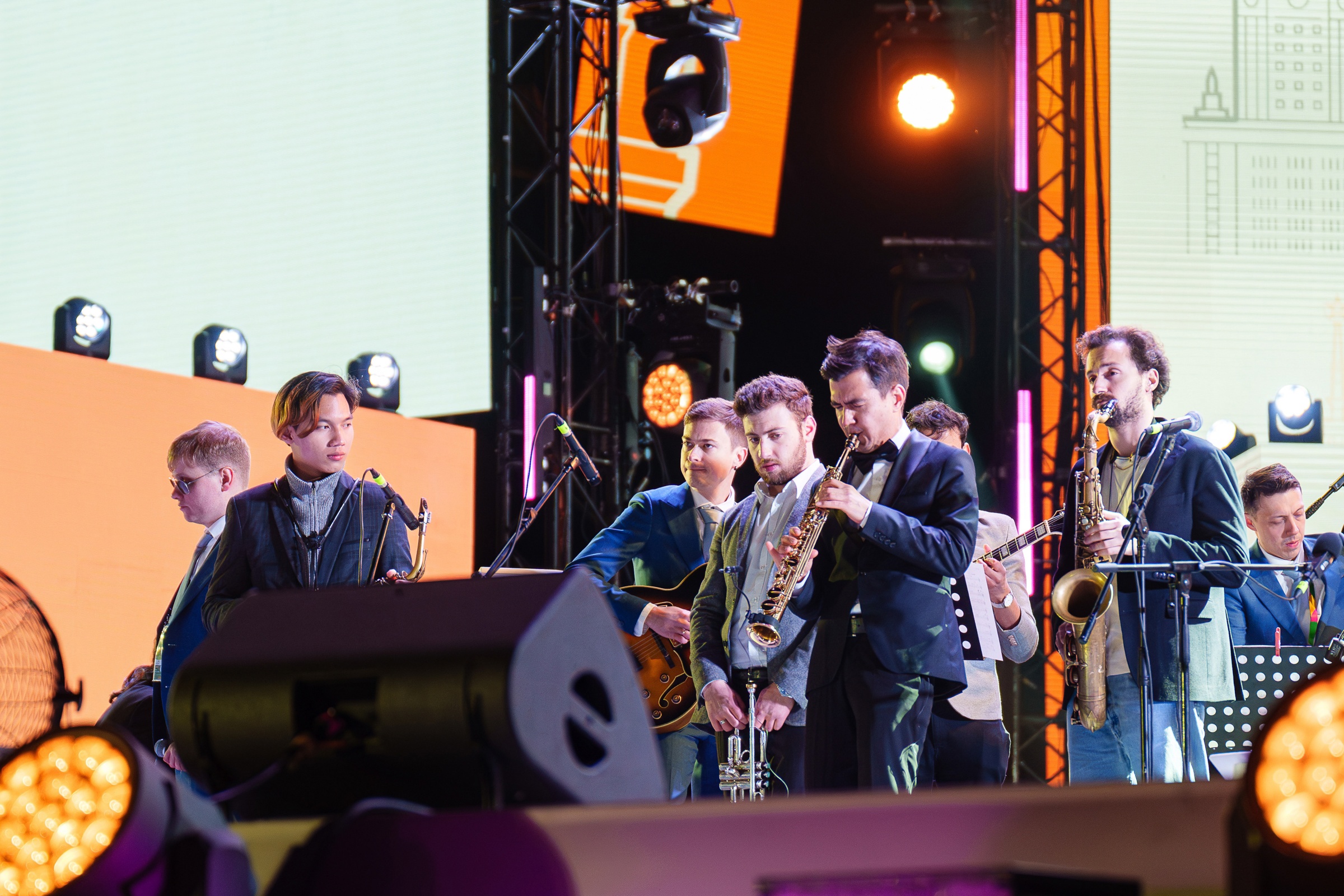
– What special projects should we expect?
– We are planning to launch new educational programs for musicians, including the revival of the "Jazz Umidlari" (Jazz Hopes) project and the relaunch of Ilkhom Jazz Club. However, much depends on funding.
There is government support, but it is insufficient for large-scale initiatives. We have to be enthusiasts, constantly looking for sponsors, writing letters, and making calls to attract and secure the necessary funds. When planning projects, we rely on our own resources. We need to build a financial base that will allow us to organize events using our own funds, so as not to depend on external assistance.
Despite these challenges, we have already received support. For example, the Fund for the Development of Culture and Arts covered our trips to The St. Petersburg International Jazz Festival and The Venice Art Biennale, where we twice represented Uzbek jazz. Such moments inspire us, but they are not enough to resolve key issues. For example, Uzbekistan does not have a jazz faculty, and establishing one would significantly improve the level of jazz performance. We discussed this issue with the U.S. Embassy, and they proposed a program that would allow us to invite a professor from the United States to lay the foundation for jazz education. This would be a crucial step in addressing this issue.
At present, funding is often allocated toward bringing in world-renowned stars. This is important for audiences, but such projects lack an educational component. Masterclasses are inspiring, but they do not provide in depth knowledge. To achieve sustainable long-term results, we need regular programs, such as one-year courses, where young musicians can study jazz disciplines in-depth.
We have already received approval from the Fund for the Development of Culture and Arts to create an educational jazz program. Our current task is to properly outline the project and work through all the details such as the number of teachers, class schedules, and salary rates. The success of the program depends on having the right structure. We need to consider everything carefully to avoid mistakes at the start.
The problem we face is evident: after major jazz festivals, young musicians feel inspired but encounter the reality that there are no specialists in institutes and music schools for teaching jazz at a high level. While pop music education in Uzbekistan is good, jazz requires a different, more specialized approach. It must be admitted that even teachers do not always know where to acquire the required knowledge in this field. If we launch a program that helps young musicians deepen their jazz knowledge, we can bridge this gap. Regular classes on improvisation, harmony, jazz theory, and ensemble performance will give talented musicians ready to learn a real chance to grow and develop their skills. We also plan to study the experiences of our colleagues in other countries to better understand how their programs are structured: which courses are in demand, which approaches are most effective. This will help us create a well-designed, functional and efficient model. At this stage, we are working on the project to make it as well-thought-out and professional as possible. We don’t just want to launch an educational program but aim to create a platform for the long-term development of jazz in Uzbekistan. With the right approach and support, this initiative could radically change the situation, give a boost to new talents, bring Uzbek jazz to a global level. Give us a little time, and we will definitely turn this idea into reality. After all, when enthusiasm meets support, truly significant things are created. – On which music platforms can you be found? – Currently, we are not on music platforms, but we plan to upload our tracks to Spotify, Yandex Music, YouTube, and others. Ten years ago, we released an album, and we will definitely make it available online. Over the years, we have accumulated a lot of new material, which, for now, we only perform at concerts. Our goal is to record and release albums. In addition, we have unique compositions with a symphony orchestra, which we also want to record and share with our audience. – What are your upcoming creative plans? – We are preparing to participate in the Baku Jazz Festival this fall. We were supposed to be invited last year, but there was a mix-up that the organizers confused the format and scheduled us to perform ethnic hip-hop, although we had planned to perform jazz with Uzbek motifs at the Mugham Center. It was decided to postpone our performance to the following year, and now we are confident that everything will go as planned. Honestly, this incident only fueled our desire to make the performance even more vibrant and memorable, showcasing the unique blend of jazz and Uzbek music. Also, last summer, prominent musician and producer Anvar Kalandarov contacted us. He expressed a desire to release our first album on vinyl in Europe and the U.S. and support its promotion on the international market. So, I think our first vinyl records will be available for purchase next year. – Have you ever thought about trying a different musical genre? – We stopped considering ourselves solely jazz musicians a long time ago. We use that name for simplicity, but in reality, we are much broader than that—we are simply musicians. Jazz is an amazing genre, but it is not the only way to express oneself. We don’t strive to play classic American jazz because that would require fully immersing ourselves in the genre and dedicating ourselves solely to it. However, such an approach would lead to creating a good copy rather than finding our own identity. Copying at the initial stage is fine, but it’s important not to get stuck in it and to find something of our own. For that, the right environment is crucial, as musicians can inspire each other and create something unique. I believe we have found our style by interpreting folk melodies through the lens of ethno-jazz, so for now, we are not considering switching to another style. Instead, we want to delve deeper into what we have already created and develop it further. – What is Jazzirama’s ultimate dream? – To continue growing and experimenting while staying true to our uniqueness. We prefer playing the instruments we are familiar with because that’s where we feel confident. Of course, each of us can play other instruments a little, but our main focus remains on those that have become our signature. At the same time, we are thinking about incorporating new technologies. For example, electronic wind controllers, which can reproduce any sound and offer space for experimentation, are becoming increasingly popular. We are also considering the possibility of creating electronic projects that would incorporate DJ controllers, loopers, beat machines, and other modern devices. This could add a fresh, contemporary touch to our music. We are open to experiments and hope to combine traditional sounds with new technologies, creating something unique and exciting.
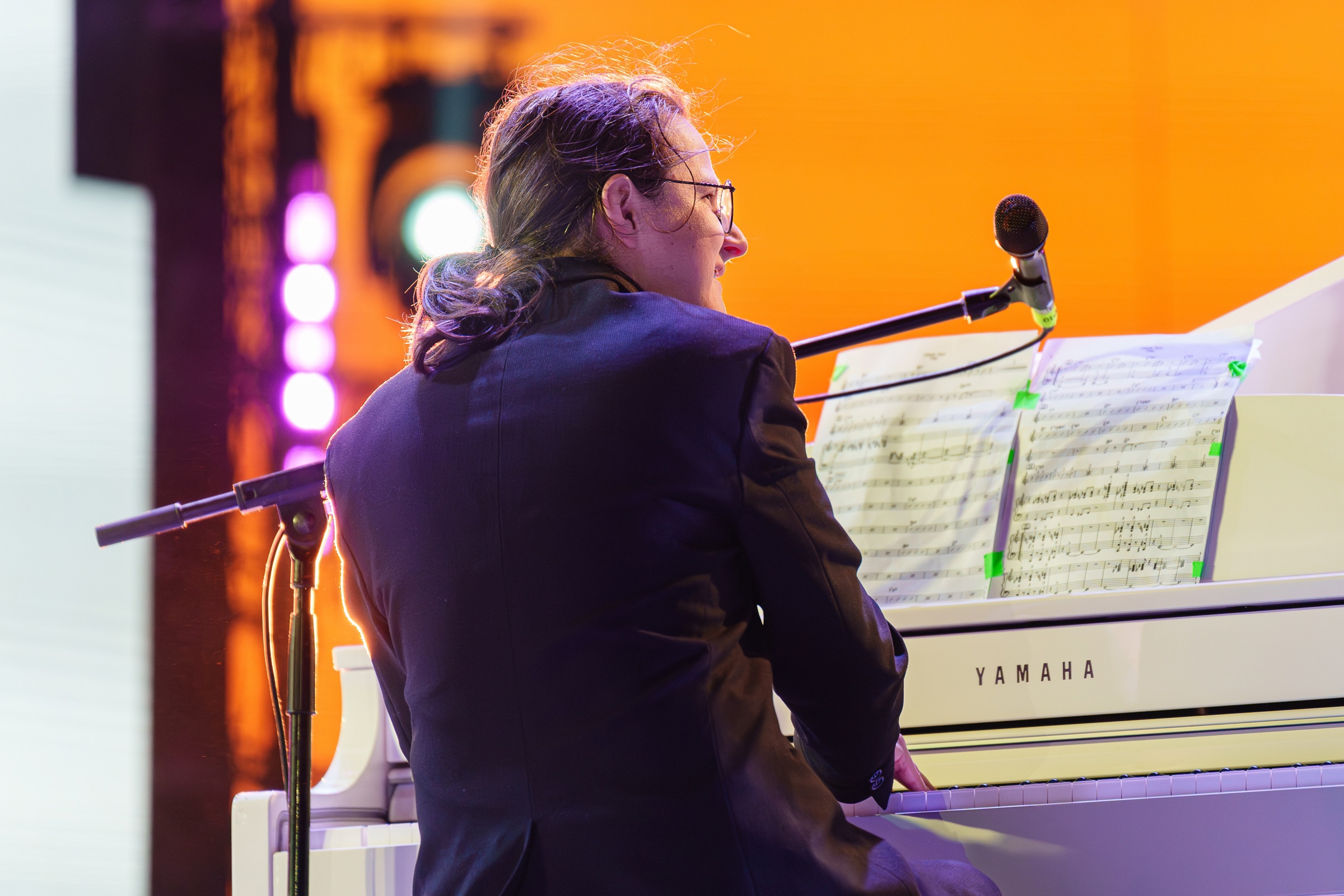
– If jazz and Uzbek musical motifs didn’t exist, what would Jazzirama perform?
– At this moment, the band’s co-founder, Sanjar Nafikov, joined the conversation and his remark was incredibly vivid:
"If jazz and Uzbek musical motifs didn’t exist, we would have invented them!"
Saidmurat added: "Yes, these two cultural elements reflect us so deeply that if one of them were missing, we would surely compensate for it with something of our own. Perhaps we would create a new style based on other ethnic melodies or rhythms, incorporating the emotions and feelings that jazz and national music bring to us. After all, the most important thing for us is the freedom of self-expression and conveying a story through sound".
